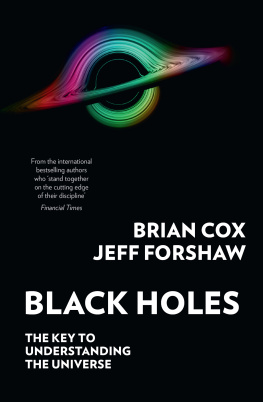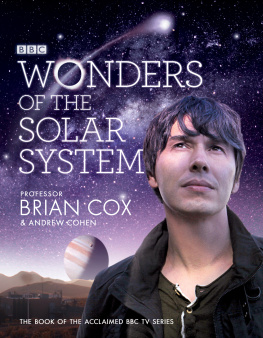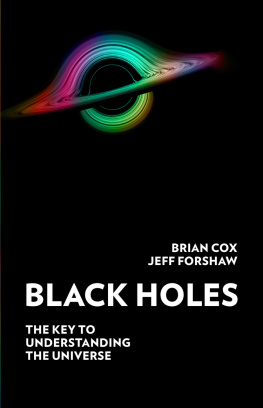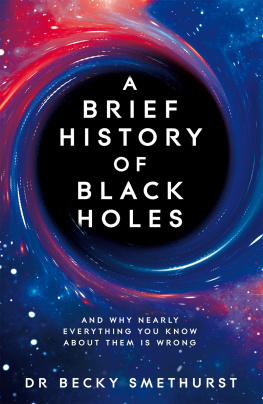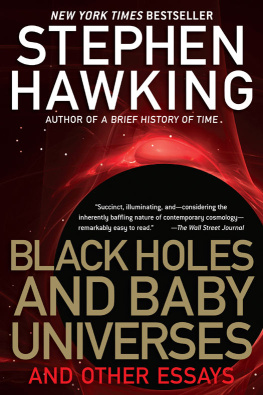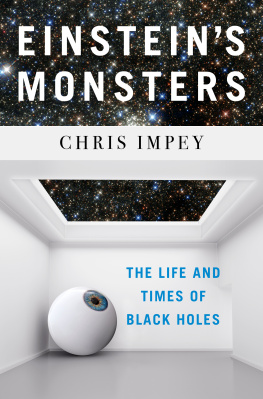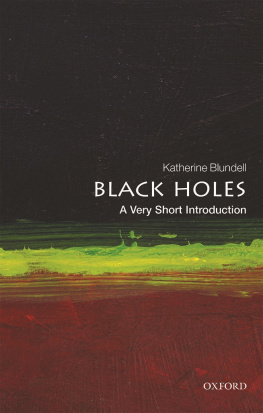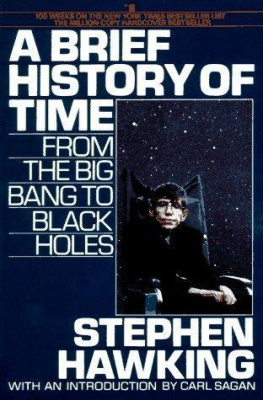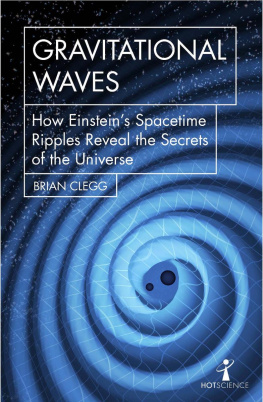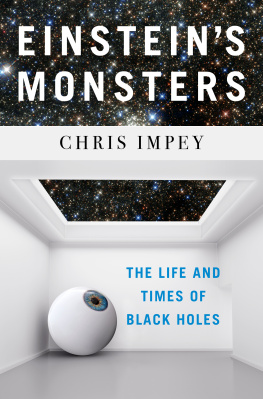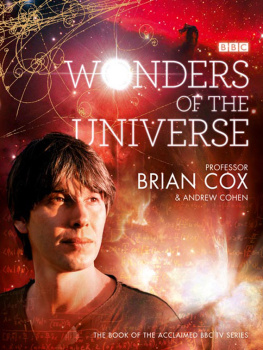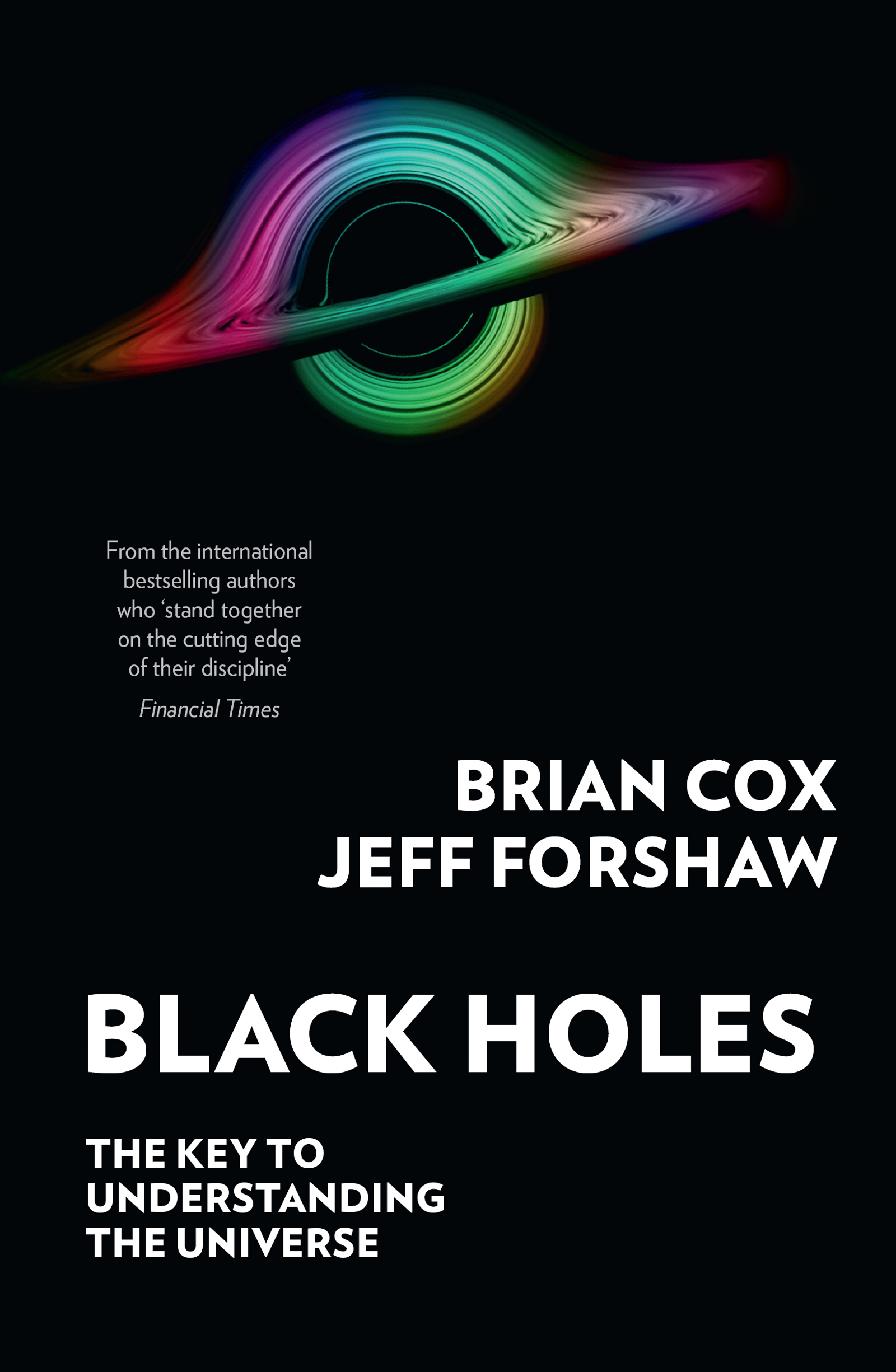Contents
Guide
For Jeffs mum, Sylvia.
CONTENTS
A knowledge of the existence of something we cannot penetrate, of the manifestations of the profoundest reason and the most radiant beauty it is this knowledge and this emotion that constitute the truly religious attitude; in this sense, and in this alone, I am a deeply religious man.
Albert Einstein
At the heart of the Milky Way, there is a distortion in the fabric of the Universe caused by something 4 million times more massive than our Sun. Space and time are so warped in its vicinity that light rays are trapped if they venture closer than 12 million kilometres. The region of no return is bounded by an event horizon, so named because the Universe outside is forever isolated from anything that happens within. Or so we used to think when the name was coined. We have named it Sagittarius A* and it is a supermassive black hole.
Black holes lie where the most massive stars used to shine, at the centres of galaxies and at the edge of our current understanding. They are naturally occurring objects, inevitable creations of gravity if too much matter collapses into a small enough space. And yet, although our laws of Nature predict them, they fail to fully describe them. Physicists spend their careers looking for problems, conducting experiments in search of anything that cannot be explained by the known laws. The wonderful thing about the increasing number of black holes we have discovered dotted across the sky is that each one is an experiment conducted by Nature that we cannot explain. This means we are missing something deep.
The modern study of black holes begins with Einsteins General Theory of Relativity, published in 1915. This century-old theory of gravity leads to two startling predictions: First, that the fate of massive stars is to collapse behind an event horizon to form a black hole which will contain a singularity; and secondly, that there is a singularity in our past which constitutes, in some sense, a beginning to the universe. This remarkable sentence appears on the first page of a seminal textbook on general relativity, The Large Scale Structure of Space-Time, written in 1973 by Stephen Hawking and George Ellis. It introduces evocative terms black hole, singularity, event horizon which have become part of popular culture. It also says that at the end of their lives, the most massive stars in the Universe are compelled by gravity to collapse. The star vanishes, leaving an imprint in the fabric of the Universe. But behind a horizon, something remains. A singularity, a moment rather than a place when our knowledge of the laws of Nature breaks down. According to general relativity, the singularity lies at the end of time. There is also a singularity in our past, which marks the beginning of time: the Big Bang. We are asked to accept the profound idea that our scientific description of gravity, the familiar force that governs the behaviour of cannon balls and moons, is at its heart concerned with the nature of space and time.
Its not obvious that gravity should be related to space and time, let alone that seeking to describe it in a scientific theory might lead one to contemplate the beginning and end of time. Black holes take centre stage in exploring this deep relationship because they are gravitys most extreme observable creations. They are so intellectually troublesome that well into the 1960s many physicists felt that while black holes are a feature of the mathematics of general relativity, Nature would surely find a way to avoid creating them. Einstein himself wrote a paper in 1939 in which he concluded that black holes do not exist in physical reality. Einsteins illustrious contemporary Arthur Eddington put it in rather pithier terms: There should be a law of Nature to prevent a star from behaving in this absurd way. Well, there isnt, and they do.
We now understand that black holes are a natural and unavoidable phase in the lives of stars a few times more massive than our Sun, and since there are many millions of such stars in our galaxy, there are many millions of black holes. Stars are large clumps of matter fighting gravitational collapse. In the early stage of their lives, they resist the inward pull of their own gravity by converting hydrogen into helium in their cores. This process, known as nuclear fusion, releases energy which creates a pressure that halts the collapse. Our Sun is currently in this phase, converting 600 million tonnes of hydrogen into helium every second. Its easy to skim over very large numbers in astronomy, but we should pause and marvel at the terrifying difference in scale between the stars and the objects of everyday human experience. Six hundred million tonnes is the mass of a small mountain, and our Sun has been steadily burning through a mountains-worth of hydrogen every second since before the Earth formed. Not to worry; it has enough hydrogen left to continue its tussle with gravity for another 5 billion years. The Sun can do this because it is big; a million earths would fit comfortably inside. It is 1.4 million kilometres in diameter; a passenger jet would have to fly for six months to circumnavigate it. And yet the Sun is a small star. The largest known stars are a thousand times larger, with diameters in the region of a billion kilometres. Placed at the centre of our solar system, such stars would engulf Jupiter. Monsters like these will end their lives in catastrophic gravitational collapse.
Gravity is a weak but inexorable force. It only attracts, and in the absence of any stronger counteracting forces, it attracts without limit. Gravity is trying to pull you through the floor towards the centre of the Earth, and its pulling the ground in the same direction. The reason everything doesnt collapse to a central point is that matter is rigid; its built out of particles that obey the laws of quantum physics and repel each other when they approach too closely. But the rigidity of matter is something of an illusion. We fail to perceive that the ground below us is essentially empty space. The dancing electron clouds surrounding atomic nuclei keep atoms apart and fool us into thinking that solid objects are densely packed. The reality is that the atomic nucleus occupies only a tiny fraction of the volume of an atom and that the ground below our feet is as insubstantial as vapour. The repulsive forces inside matter are nevertheless very powerful and they are capable of keeping you from falling through the floor, and of stabilising dying stars up to twice the mass of the Sun. But there is a limit, and that limit is explored by neutron stars.
A typical neutron star has a radius of just a few kilometres and a mass around 1.5 times that of the Sun. A million Earths squashed into a region the size of a city. Neutron stars tend to spin very fast, emitting bright beams of radio waves that illuminate the Universe like a lighthouse. The first observation of such a neutron star, known as a pulsar, was made by Jocelyn Bell Burnell and Antony Hewish in 1967. So regular is the pulse, which sweeps over Earth every 1.3373 seconds, that Bell Burnell and Hewish christened it Little Green Men-1. The fastest pulsar yet discovered, known as PSR J1748-2446ad, rotates 716 times every second. Neutron stars are extremely energetic celestial objects. On 27 December 2004, a burst of energy hit the Earth, blinding satellites and expanding our ionosphere. The energy was released by the rearrangement of the magnetic field around a neutron star called SGR 1806-20, which lies 50,000 light years from Earth on the other side of the galaxy. In a fifth of a second the star radiated more energy than our Sun emits in a quarter of a million years.

